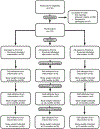A randomized trial comparing diet and delivery strategies for weight management in adolescents with intellectual disabilities
- PMID: 36054481
- PMCID: PMC9940267
- DOI: 10.1111/ijpo.12972
A randomized trial comparing diet and delivery strategies for weight management in adolescents with intellectual disabilities
Abstract
Background: The literature evaluating multi-component interventions for long-term weight loss in adolescents with intellectual disabilities (ID) is extremely limited.
Objectives: To compare the effectiveness of two delivery strategies, face-to-face (FTF) or remote delivery (RD), and two diets, enhanced Stop Light diet (eSLD) or conventional diet (CD) on weight change across 12 and 18 months. in response to an 18 months. weight management intervention (6 months Weight loss/12 months. Weight maintenance) in adolescents with ID.
Methods: Adolescents with ID were randomized to one of three arms: FTF /CD, RD/CD, RD/eSLD and asked to attend individual education sessions with a health educator which were delivered during FTF home visits or remotely using video conferencing. The CD followed the US dietary guidelines. The eSLD utilized the Stop Light guide and was enhanced with portion-controlled meals. Participants were also asked to increase their physical activity (PA) and to self-monitor diet, PA and body weight across the 18-month.
Results: Weight was obtained from 92(84%) and 89(81%) randomized adolescents at 12 and 18 months, respectively. Weight change across 12 months. Differed significantly by diet (RD/eSLD: -7.0% vs. RD/CD: -1.1%, p = 0.002) but not by delivery strategy (FTF/CD: +1.1% vs. RD/CD: -1.1%, p = 0.21). Weight change across 18 months. Was minimal in all intervention arms and did not differ by diet (RD/eSLD: -2.6% vs. RD/CD: -0.5%; p = 0.28) or delivery strategy (FTF/CD: +1.6% vs. RD/CD: -0.5%; p = 0.47).
Conclusions: Additional research is required to identify effective strategies to improve long-term weight loss in adolescents with ID.
Keywords: autism; body composition; down syndrome; physical activity; weight loss; youth.
© 2022 World Obesity Federation.
Figures



References
-
- Schalock RL, Luckasson R, Tasse MJ. Intellectual Disability: Definition, Diagnosis, Classsification, and Systems of Supports. 12th ed. American Association on Intellectual and Developmental Disabilities; 2021. - PubMed
-
- Zablotsky B, Black LI, Blumberg SJ. Estimated prevalence of children with diagnosed developmental disabilities in the United States, 2014–2016. NCHS Data Brief. 2017;291:1–8. - PubMed
-
- Maïano C, Hue O, Morin AJ, Moullec G. Prevalence of overweight and obesity among children and adolescents with intellectual disabilities: a systematic review and meta-analysis. Obes Rev. 2016;17(7): 599–611. - PubMed
-
- Grondhuis SN, Aman MG. Overweight and obesity in youth with developmental disabilities: a call to action. J Intellect Disabil Res. 2014; 58(9):787–799. - PubMed
-
- Bertapelli F, Pitetti K, Agiovlasitis S, Guerra-Junior G. Overweight and obesity in children and adolescents with down syndrome-prevalence, determinants, consequences, and interventions: a literature review. Res Dev Disabil. 2016;57:181–192. - PubMed
Publication types
MeSH terms
Grants and funding
LinkOut - more resources
Full Text Sources
Miscellaneous

